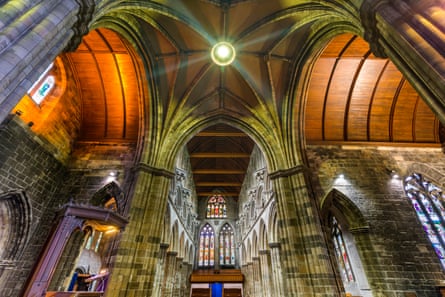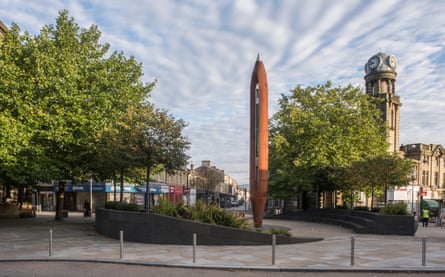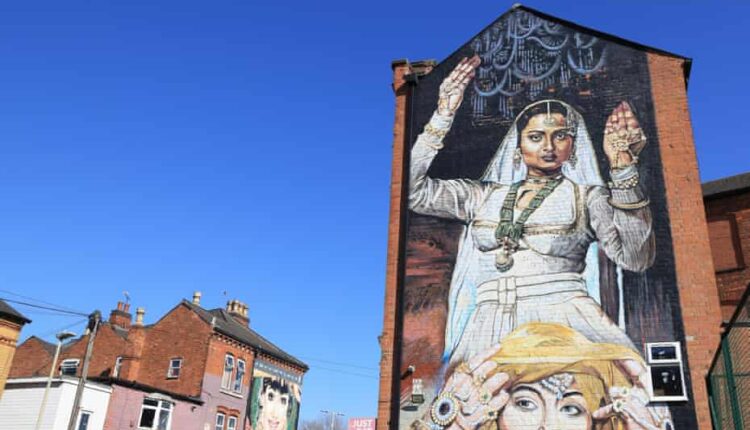Where tourists seldom tread, part 19: three UK towns with industrial legacies.
We discover the Roman, Tudor, and Indian delights of Leicester, Paisley’s textile and ecclesiastical legacy, and Nelson’s radical history, the only town named after a bar.
A pint in the Globe provided some thinking time and, as the former preferred boozer of stockingers, a natural connection to Victorian and Edwardian Leicester, which was brimming with business energy.
Thomas Cook, Walkers crisps, Wolsey clothes, and Currys all got their beginnings here. Garments, hosiery, and corsetry made the city resemble a Lancashire town. Chimneys, mills, and, most reassuringly, makers are still visible.
The 21st-century city is multipurpose – the centre has expanded from retail to gaming, coworking, education, dining, cocktails, and cafes – and notoriously diverse.
The Golden Mile (Belgrave Road) is a bustling, gimmick-free Asian shopping district for clothing, jewellery, spices, fresh produce, and eateries. Bobby’s, with its Bollywood-inspired décor, and Sharmilee received the city’s Curry Capital award in 2024. Belgrave Road was part of the Fosse Way, which is thought-provoking; ancient Rome was also multicultural.
Someone on Reddit wonders, “Why is Paisley even still a place?” Sixty comments follow. Finally, I know Paisley is a location. As an English northerner, I had assumed it was someplace vague – suburb, district, city borough.
But even on the non-stop train (nine minutes from Glasgow Central), you know you’re passing through a true green belt, and when you arrive, you see spires and domes above the trees. Paisley stands out; it is tall.
Bold architecture hints of prosperous textile era. The station, Scotland’s fourth busiest, is Scots baronial. The town hall is a spacious neoclassical building that was recently converted into a music venue.
The enormous Abbey, erected on the site of a 12th-century Cluniac monastery, is a gloomy hulk (only slightly subverted by a funny “Alien” gargoyle).
St Matthew’s church, constructed by local architect William Daniel McLennan, is a blend of perpendicular and art nouveau architecture, influenced by Charles Rennie Mackintosh’s Queen’s Cross church in Glasgow, but more pronounced and stunning.
On White Cart Water, there are two gigantic mills. The huge Anchor Mills is residential and situated next to a weir that looks like a wild waterfall. Mile End Mill is a business centre with an impressive chimney, coffee shop, and modest textile museum.
The imposing gothic hulk of the Coats building, built as a memorial church and nicknamed the Baptist Cathedral of Europe, is today a venue for weddings, proms and the set of the TV series Outlander. Paisley has done a lot of repurposing.

The Paisley design appears in street art and the Buddie Walk of Fame, a set of ten plaques located throughout the town centre that celebrate local legends, both living and dead.
They include Fulton Mackay from the TV show Porridge; playwright, designer, and painter John Byrne, whose Slab Boys Trilogy, originally titled Paisley Patterns, is set in a carpet-making factory; Tom Conti; David Tennant; Paolo Nutini; Phyllis Logan; and Gerry Rafferty (whose Baker Street can be read as an angst-ridden lament from London to his hometown of Paisley).
Byrne and Rafferty’s memorials should have been erected in Ferguslie Park, the socially marginalised region from which they came.
As did Gordon Williams, author of the novel From Scenes Like These, a searing, honest, humorous account of socioeconomic deprivation, violence, sex, and booze that was nominated for the inaugural Booker Prize in 1969. The novel was long forgotten but was suddenly unearthed. Like Paisley.
No town is created completely from scratch, but Nelson in Lancashire comes close. An early description was “a peat-covered and rain-soaked wilderness.” An 1844 map depicts a cotton industry, two churches, the New Inn, and a post office.
The canal, which opened in 1816, allowed the young community to convey its commodities. When the railway opened in 1849, it was named Marsden, but there was already a Marsden in Yorkshire.
As the train came to a stop before the Lord Nelson Inn, the guard would exclaim “Nelson!” The name stayed. Locals, half-heartedly, claim that it is the only town named after a tavern.
Two thousand terrace dwellings sprung up around the station, many of which are still standing, with a gridiron layout. In the mid-19th century, Nelson had nine small general stores, two drapers, two druggists, one tailor, and one stationer.
There was a saddler’s shop and two blacksmiths. By 1876, these had expanded to include butchers, cabinet-makers, chemists, cloggers, drapers, glass and china dealers, grocers, greengrocers, ironmongers, and tobacconists, as well as corner shops, fish-and-chip shops, and 21 grocery and provisions branches administered by the Society.
There were more than a dozen bars and churches/chapels. What towns and townsfolk miss is not limited to what we recall from our own lives.
More than 20 mills clacked and whirred, along with thousands of looms. By 1921, about 18,000 Nelson residents employed in weaving, with men and women evenly represented. Textiles accounted up 90% of Nelson’s buildings and people. I’d noticed the decrepit Whitefield Mill from the canalside.
Riverside Mill’s only remaining structure is a chimney. Lomeshaye Bridge Mill and Spring Bank Mill continue to exist as mixed-use sites. Brierfield Mill has been turned into luxurious flats.
A 40-foot-high shuttle on the high street is intended to remind people of the weaving heyday; yet, it is an ineffective monument that conveys nothing of the power, graft, pain, or pride of the past.

There were other minor enterprises in brewing, quarrying, coal mining, grain milling, soap production, brick and pipe manufacturing, and construction.
The Victory V lozenge, initially manufactured with ether and chlorodyne (a mixture of chloroform, the narcotic laudanum, and cannabis), was a local creation. In the 1860s, an Austrian confectioner working at Fryers created a more mass-market mouthwatering treat.
He was tasked with creating a mould for jelly bears, but the end result resembled newborn newborns. They were renamed as “Unclaimed Babies”. That moniker did not stick, and thus Jelly Babies were born.
Nelson is a sanctuary for radical leftists. Weaving unions were strong and frequently militant.
A local publication dubbed the place Little Moscow. The first world war saw the rise of a sizable pacifist movement, resulting in schisms between conscientious objectors and those who supported the national military goals.
Ethel Carnie Holdsworth, Britain’s first working-class female author, spoke to a 20,000-strong gathering at Victoria Park (previously Victoria Recreation Ground) as part of the Women’s Peace Crusade, advocating for an end to war. Her 1925 novel, This Slavery, has just been reworked in graphic format.
The Unity Wellbeing Centre on Vernon Street, which established in 1908 as the Independent Labour Party Socialist Institute, finest exemplifies local radical history.
One foundation stone was put in commemoration of William Morris and Edward Fay by Katharine Bruce Glasier, a famous ILP politician described as “the grandmother of the Labour party”.
The second was laid in memory of Caroline Martyn and Enid Stacy by Selina Cooper, who had relocated to Nelson from Cornwall with her family in 1875 when her father died.
She began working at the mills part-time when she was 10 years old, and full-time when she was 13. Cooper was a key figure in politicising and mobilising local female textile workers.
She lived at 59 St Mary Street, which has a plaque, but not an official English Heritage one.
The alleys of stone terraces are picturesque, and many lead to bracing views of Pendle Hill’s south-eastern face and the steep slope that descends from the summit, known as the Big End and popular with fell runners.
Nelson also offers up mental vistas, as pilgrims journey in both directions: to the fells and moors, as well as to the cobbled streets and regenerated mills.
Read more on Straightwinfortoday.com


Comments are closed, but trackbacks and pingbacks are open.